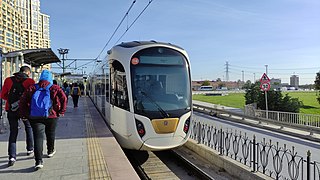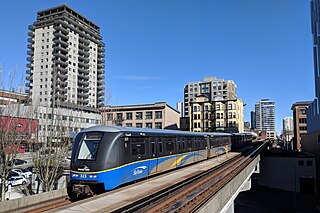
The Toronto subway is a rapid transit system serving Toronto and the neighbouring city of Vaughan in Ontario, Canada, operated by the Toronto Transit Commission (TTC). As of September 2023, the subway system is a rail network consisting of three heavy-capacity rail lines operating predominantly underground. As of December 2022, three new lines are under construction: two light rail lines and one light metro line.

The Alstom Citadis is a family of low-floor trams and light rail vehicles built by Alstom. As of 2017, over 2,300 Citadis trams have been sold and 1,800 tramways are in revenue service throughout the world, with operations in all six inhabited continents. An evolution of Alstom's earlier TFS vehicle, most Citadis vehicles are made in Alstom's factories in La Rochelle, Reichshoffen and Valenciennes, France, and in Barcelona, Spain, and Annaba, Algeria.

A low-floor tram is a tram that has no stairsteps between one or more entrances and part or all of the passenger cabin. The low-floor design improves the accessibility of the tram for the public, and also may provide larger windows and more airspace.

A tram-train is a type of light rail vehicle that both meets the standards of a light rail system, and also national mainline standards. Tramcars are adapted to be capable of running on streets like an urban tramway but also be permitted operation alongside mainline trains. This allows services that can utilise both existing urban light rail systems and mainline railway networks and stations. It combines the urban accessibility of a tram or light rail with a mainline train's greater speed in the suburbs.

The Bombardier Flexity Swift is a series of urban and inter-urban tram, light rail and light metro vehicles manufactured by Bombardier Transportation. It is part of the Bombardier Flexity family of rail vehicles, and like the others, Flexity Swift vehicles can be customized to suit the needs and requirements of customers including legacy designs from its acquisition of Adtranz.

The Trillium Line, also called O-Train Line 2, is a diesel light rail transit (DLRT) service in Ottawa, Ontario, Canada, operated by OC Transpo. The line has been closed since May 2020 for service expansion.
Bombardier Transportation was a Canadian-German rolling stock and rail transport manufacturer, with headquarters in Berlin, Germany. It was one of the world's largest companies in the rail vehicle and equipment manufacturing and servicing industry. Bombardier Transportation had many regional offices, production and development facilities worldwide. It produced a wide range of products including passenger rail vehicles, locomotives, bogies, propulsion and controls. In February 2020, the company had 36,000 employees, and 63 manufacturing and engineering locations around the world. Formerly a division of Bombardier Inc., the company was acquired by French manufacturer Alstom on 29 January 2021.

Île-de-France Mobilités, formerly STIF, is the brand name of the Syndicat des transports d'Île-de-France, the organisation authority that controls and coordinates the different transport companies operating in the Paris-area public transport network and rest of Île-de-France region. It coordinates the operation of RATP Group, SNCF Transilien and the nearly 90 Optile-affiliated private bus companies.

Line 5 Eglinton is a light rail line that is under construction in Toronto, Ontario, Canada. Owned by Metrolinx and operated by the Toronto Transit Commission (TTC), the line will be part of the Toronto subway system as its fifth route. The first phase of the 19-kilometre (12 mi) line will include 25 stops along Eglinton Avenue, from Mount Dennis station underground to Laird station, after which it will run predominantly at-grade within the street's median to Kennedy station, where it will connect underground with Line 2 Bloor–Danforth. The line was initially designed to connect with Line 3 Scarborough; however, Line 3 was decommissioned in 2023. Line 5 is scheduled to open in 2024, with an estimated cost of CA$12.82 billion; the cost when the contract was awarded was pegged at $9.1 billion, although the cost was originally estimated at $11 billion.

Line 6 Finch West, also known as the Finch West LRT, is a light rail line under construction in Toronto, Ontario, Canada, to be operated by the Toronto Transit Commission. The 10.3-kilometre (6.4 mi), 18-stop line is to extend from Finch West station on Line 1 Yonge–University to the North Campus of Humber College in Etobicoke. The line will operate in a dedicated above-ground right-of-way, much of it within Finch Avenue, segregated from street traffic. The line will use transit signal priority and standard gauge rather than the broad Toronto gauge. The line is forecast to carry about 14.6 million rides a year or 40,000 a day by 2031 and will replace the 36 Finch West bus route, which is one of the three busiest bus routes in Toronto. The line is expected to open within the first half of 2024, with an estimated cost of CA$2.5 billion.

Trams in France date from 1837 when a 15 km steam tram line connected Montrond-les-Bains and Montbrison in the Loire. With the development of electric trams at the end of the 19th century, networks proliferated in French cities over a period of 15 years. Although nearly all of the country's tram systems were replaced by bus services in the 1930s or shortly after the Second World War, France is now in the forefront of the revival of tramways and light rail systems around the globe. Only tram lines in Lille and Saint-Étienne have operated continuously since the 19th century; the Marseille tramway system ran continuously until 2004 and only closed then for 3 years for extensive refurbishment into a modern tram network. Since the opening of the Nantes tramway in 1985, more than twenty towns and cities across France have built new tram lines. As of 2020, there are 29 operational tram networks in France, with 3 more planned. France is also home to Alstom, a leading tram manufacturer.

The Istanbul Tram is a modern tram system on the European side of Istanbul. The first section, the T1 opened in 1992, followed by the T2, which opened in 2006. In 2011, the T1 and T2 merged, with the line retaining the T1 name. The T4 and the T5 lines followed, opening in 2007 and 2021, respectively.

The Hurontario LRT is a light rail line under construction in the cities of Mississauga and Brampton, Ontario, Canada. The line will run along Hurontario Street from Mississauga's Port Credit neighbourhood north to Steeles Avenue in Brampton. The line will be built and operated as a public-private partnership by Mobilinx, a consortium of private European and Japanese companies, with provincial transit agency Metrolinx retaining ownership of the line. It will be the only street railway operating in the Greater Toronto Area outside Toronto proper.

The Hamilton LRT is a planned light rail line in Hamilton, Ontario, Canada, to operate along Main Street, King Street, and Queenston Road. It is one of five planned rapid transit lines which form Hamilton's proposed BLAST network. The 14 km (8.7 mi), 17-stop route is planned to extend from McMaster University to Eastgate Square via downtown Hamilton.

The Confederation Line, also called O-Train Line 1, is a light rail line operated by OC Transpo in Ottawa, Ontario, Canada, as part of the city's O-Train light rail system. It opened on September 14, 2019, and is O-Train's second line. It operates on an east–west route, with a segment under Queen Street in the downtown core, complementing the north–south Trillium Line that operates to the west of the downtown core. Using light rail rolling stock and technology, the Confederation Line is completely grade separated.

The Circular light rail is a light rail line in Kaohsiung, Taiwan, operated by Kaohsiung Rapid Transit Corporation. The southern part of this line makes use of the defunct tracks of the Kaohsiung Harbor Railway Line. Construction cost was forecasted to be 16.5 billion New Taiwan dollars.

The Flexity Freedom is a low-floor, articulated light rail vehicle developed by Bombardier Transportation for the North American market. It is marketed as part of the Bombardier Flexity family which includes other models of trams (streetcars) and light metro vehicles. They are produced in facilities in Thunder Bay and Kingston, Ontario, which once produced rolling stock under the names of Canada Car and Foundry (CC&F) and Urban Transportation Development Corporation (UTDC), respectively.

The Alstom Flexity is a family of trams, streetcars and light rail vehicles manufactured by Bombardier Transportation, since 2021 a division of French company Alstom. As of 2015, more than 3,500 Flexity vehicles are in operation around the world in Europe, Asia, Oceania, and North America in 100 cities among 20 countries internationally. Production of the vehicles is done at Bombardier's global production plants and by local manufacturers worldwide through technology transfer agreements.

Belfast Yard is the maintenance, storage and administrative facility for LRT fleet for the Confederation Line of Ottawa's O-Train light rail system. The yard was opened in 2016 and assembled 34 Alstom Citadis Spirit LRT vehicles. The facility was expanded to accommodate 38 additional LRT vehicles as part of the Stage 2 Confederation Line expansion.

Urban rail transit in Canada encompasses a broad range of rail mass transit systems, including commuter rail, rapid transit, light rail, and streetcar systems.




















